Leland Stanford Junior University Football Offensive Preview
Cal hasn't seen an offense this bad since... Colorado.
It’s Big Game Week, and after an awful season of misery, it’s time for the Stanford Cardinal to take on the Cal Bears. These two schools are uncomfortably similar this season, and trying to make sense of heads or tails, I turned to our AI Overlords to tell me what would happen in the 2022 edition of the Big Game:
Is that a bear cutting down a tree with the blunt end of an axe? Yes, that sounds like an appropriate allegory for the game: the tree is not going to hurt the bear, but if the bear could just figure out how to attack, the bear would make short work of the tree.
Now, I don’t want to get political here, but I have to make a rare exception when discussing politically laden Stanford. Normally I don’t support police brutality, but this here is a rare exception:

Now, I’m going to take a lot of unfair shots at Stanford, and a reasonable person might say, “Hey, doesn’t that also apply to Cal as well?” I’m going to need you to overlook that, because there’s no room to be reasonable this week. It’s BIG GAME WEEK.
Take, for instance, this fan of Stanford football. Despite Stanford holding onto a tenuous lead, he has the defeated face of a fan who has already lost:

Why? Because as an Old Blue Red (?), he knows what’s to come:

I couldn’t pick just one picture here, they all bring me so much joy that I just had to turn it into a whole slideshow. (You can find the play they are reacting to in last week’s article.)
Stanford has finally become the team everyone predicted they’d become after Jim Harbaugh left. Sure, it took a couple more years than expected, and credit to David Shaw for keeping Stanford afloat longer than expected. But now, Stanford is the team that when you lose to them, it ruins your season and gets your coaches fired (just ask Clay Helton). Cal, in a clever move of jiu jitsu, decided to fire their offensive coordinator and offensive line coach before the game, which I am pretty sure future-proofs Cal’s offense until at least the end of the season (prior to this, I expected Cal to fire the above-mentioned offensive coaches after a loss to Stanford, because there is no further rock bottom than a Stanford loss after also losing to Colorado).
I was given the impression at Pac-12 Media Day that there was no game more important to Stanford than USC, and that impression was reinforced during their surprise debut of their new slow mesh offensive system in that game (while it caught USC by surprise, it has sputtered and stalled since). And while I admire their desire to ruin USC’s season, I have to believe that Cal wouldn’t overlook Stanford in the way Stanford seems to be overlooking the Big Game.
I think there’s one other key factor that has been working against Stanford this season. As embarrassing as it is to admit this, I had developed a sympathy for Stanford this season after meeting QB Tanner McKee and CB Kyu Blu Kelly at Pac-12 Media Day earlier this year. They’re both great players that’ll soon be playing in the NFL, and while I freely disrespected most of Stanford’s players in last year’s previews, they were some of the only players I didn’t (cf. offense, defense). They were smart and thoughtful; sympathetic. That’s their downfall.
You see, any team I root for is probably doomed; the Cal Bears, Jared Goff and the Detroit Lions, the Los Angeles Lakers, and so on (I don’t even want to admit all of the teams I am a fan of). I don’t think it’s any coincidence that when USC and UCLA announced they were leaving for the Big Ten and I started rooting even harder against them that they are now enjoying their best seasons since the early aughts. Science can’t explain that. I’ve been hoping for Tanner McKee to do well in every game but one this season so that he can quickly leave for the NFL, and instead he’s struggled this season.
Of course, I wouldn’t pin the blame entirely on him; the entire offense is terrible. They are 11th in the conference in points per game (Colorado is 12th). They can’t run the ball at all, and despite having an NFL-caliber quarterback, they have the 10th ranked passing offense in the conference (Colorado is 12th, and a team that doesn’t throw the ball much, Oregon State, is 11th). I think McKee is great, but he’s not getting much help. Let’s take a closer look.
Offensive line
We have to start here, with the offensive line. When you have such a porous offensive line, you can see how an NFL talent in the backfield ends up posting pedestrian stats (please ignore the parallels to Jaydn Ott and Cal):
Since the USC game, Stanford has been running a slow-mesh offense (borrowed from Wake Forest), in which the quarterback tries to ride out the mesh point with the running back. If you are in zone coverage, you put the linebackers in a bind: either the running back runs against a lighter box if the linebacker defends the pass, or the linebacker sucks in to defend the run and opens up a passing lane behind him for the QB to pull the ball back and throw. If you’re in man coverage, there is no underneath help as the linebackers have to respect the run game, and you have to play man coverage against some big Stanford receivers (who, in previous years, were deadly on endzone fades and the like).
Of course, there are a number of reasons this has not worked out for Stanford. For one thing, Stanford has no run game to respect. RB EJ Smith is a fantastic running back, but they lost him early in the season to injury. The backup running back, Casey Filkins, also lost for the season to injury. Third and fourth string running backs, Caleb Robinson and Brendon Barrow, are not lost for the season, but both have missed multiple games due to injury. Stanford’s current starting running back, Mitch Leigber, is a converted safety (he played safety earlier this year, in fact). He’s being used primarily as an extra blocker in pass protection, as this offensive line is rarely going to open up holes for him to run through.
More baffling this year is how poorly Stanford’s receivers have played, and I really don’t have a good explanation for this regression in their play. Tanner McKee is not getting much time to throw from his offensive line, but he’s also not getting much help from his big and tall contested catch receivers either.
However, the most obvious reason the slow-mesh has not been working well this season? Stanford is trying to put opposing linebackers in a bind, but the offensive line has been getting dominated by defensive lines so that it doesn’t even matter:
To hold onto the mesh, Tanner McKee has to sit in the pocket as it collapses around him, and it makes it a lot more difficult to escape the pocket when need be. Stanford has given up 34 sacks this season, last in the Pac-12 and bottom-15 in the FBS (Cal is 10th in the Pac-12, giving up a mere 30 sacks for comparison).
In fact, the only team that has shuffled their offensive line more than Stanford is… well, Cal. They’ve debuted 4 different starting offensive lines, just as many as Cal. I give Cal the edge here because Cal rotated their offensive lines more in-game (often splitting snaps between Session and Rohme, for instance), and Cal has only done so due to injury (losing their two best and most experienced offensive linemen, Matthew Cindric and Ben Coleman, to injury). Stanford, on the other hand, is back to the same starting lineup with which they started the season. Both teams have struggled with extremely porous offensive line play.
Quarterback
I think some people may be surprised at how high ranking of an NFL Draft prospect QB Tanner McKee might be, just because of all the subpar play around him. He’s got the NFL arm strength and accuracy to make all of the throws, and he definitely trusts his arm to make throws into tight windows.
Whether it’s the touch to drop it over the corner:
Or the strength to rifle it past the defender:
Of course, he has a big arm:
I think McKee has surprising escapability given his large frame, but he’s definitely limited by the offensive system he’s playing in (it’s hard for anyone to escape a sack when you’re being asked to sit still in the pocket behind an offensive line that can’t maintain a pocket). He can buy some time in the pocket with his legs (when not asked to hold that mesh point), but he’s not going to Jayden de Laura his way out of a sack and run for a first down.
In an effort to ease the burden on an overmatched offensive line, McKee will sometimes have designed rollouts and have to throw on the run. Even though he’s a pocket passer, his arm strength has allowed him to still make some nice throws on the run:
Also as a result of the porous offensive line, Stanford has also given regular snaps to their true freshman dual-threat quarterback, Ashton Daniels (similar to what they did last year with Isaiah Sanders).
Ashton Daniels most often is coming in to run the ball (17 rush attempts, 5 pass attempts):
He’s a decent runner. He’s not going to plow people like Oregon State’s Jack Colletto, but he runs the ball well enough when given a hole by the offensive line:
He was not running the ball with the best ball security, however:
Of course, when you run the ball every snap, defenses come to expect it, so you have to throw in a change of pace play every once in a while. I actually really like the way he sells the run here, with both his standard hesitation on the fake pass before he runs it, except actually selling the run fake here as well, and still throws a decent ball:
I haven’t seen him throw the ball enough to judge, but the passing here threw a wrench into this trick play (that’s Tanner McKee lined up as the outside receiver here):
It’s also too early to judge the backup, Ari Patu, but I’m skeptical he’ll be the third NFL QB after Davis Mills and Tanner McKee. Here’s a decent enough throw to the endzone:

Given McKee’s talent, it’s going to be on the Cal defense to limit the other aspects of the Stanford offense (defensive line pressure on the offensive line, linebackers stopping the run game, the secondary blanketing the receivers, etc) in order to force McKee to struggle.
Running back
I considered skipping this section because Stanford has no rushing offense. The only team with fewer rushing yards per game this season in the conference is… Cal. However, that was before Stanford lost their top four running backs to injury. Against Washington State (the game in which their 4th string RB Brendon Barrow was injured), they posted 28 carries for 71 yards (2.08 yards/carry from players not named Barrow). Against Utah, they had 26 carries for 22 yards (0.85 yards/carry).
It’s possible either Caleb Robinson or Brendon Barrow return from injury for the Big Game, to upgrade Stanford’s run game from “abysmal” to merely “terrible.”
Injury issues forced Stanford to convert safety Mitch Leigber to running back. He’s still learning the position, and while he can take yards that are given to him (which is not often with this offensive line), he’s probably not going to create many of his own:
I mean, the only difference between the above clip and a Cal game is that Jaydn Ott would have spun off the first three tacklers and broken a forth tackle to pick up a gain of two yards. Otherwise, this Stanford run game looks a lot like Cal’s.
I don’t think they really expect Leigber to do a whole lot, but it looks like he’s mainly been focused on his pass-blocking, which he does at least decently well:
I suspect Barrow might return for the Cal game. He’s got decent vision and a bit more elusiveness:
RB Caleb Robinson, who I have no highlights of, is more of a downhill runner that will try to break tackles at the line.
With their depth issues at running back, Stanford has even had Ashton Daniels line up at RB:
If Stanford finds any success on the ground, it probably spells big trouble for the Cal defense.
Receivers
While no one is surprised if a quarterback doesn’t play as well when he’s under constant pressure all game (and why I think Jack Plummer gets nowhere near the respect he deserves) or that a team missing its best running backs will struggle to run the ball, there’s really no excuse for how poorly Stanford’s talented receivers have been playing this season. Wide receiver Bryce Tremayne was an absolute stud last year, until he suffered a gruesome season-ending ankle injury at the hands of Oregon CB Dontae Manning. With him out, the Stanford passing offense then revolved around the tight end Benjamin Yurosek, a sure-handed, big play, contested catch type of receiver. In fact, that describes most of Stanford’s receivers (Tremayne is 6’4” 212 lbs, Yurosek is 6’4” 242 lbs, WR Elijah Higgins is 6’3” 234 lbs, and WR John Humphreys 6’5” 209 lbs)— although to various levels of success. It’s very clear that after the success of similar big-bodied receivers at Stanford (JJ Arcega-Whiteside, Simi Fehoko, Colby Parkinson, etc), they decided to build an entire passing offense around big-bodied receivers that can make contested catches with a quarterback accurate enough to throw them 50-50 balls (somewhere on the field there will be a 6’4”+ receiver against a smaller defensive back, and Stanford is expecting better than 50-50 odds on a jump ball against a much smaller DB). Like most things that David Shaw has done at Stanford, this worked until it didn’t.
Brycen Tremayne is Stanford’s best receiver, and although he’s been playing well this year, I feel like he hasn’t played up to the potential he showed last year. Tremayne has both the size and speed to be a difficult matchup for anyone to cover, especially when he’s playing well. Here he runs a nice route to shake another likely NFL cornerback in Rejzohn Wright:

Brycen Tremayne ends up in my highlights folder so often because he’s capable of absurd circus catches. Here he’s completely blanketed by the corner, and yet still manages to make a one-handed grab off the corner’s back:
It’s one of those plays that reminded me of what (NFL-bound) USC receivers used to do to even the best corners (like Colorado’s Chidobe Awuzie, for instance). The defensive back could do everything right, and it still wouldn’t matter. You did your job just by making the catch difficult, because they can’t do that on every throw.
Tremayne is Stanford’s best contested catch receiver (on a roster full of them), as he has a very large catch radius with strong hands to make catches away from his body as the defensive back is ripping at his arms:
Speaking of catch radius, Tremayne can lay out for the catch when the quarterback has to place the ball away from a DB:
Tremayne, as good as he is, has also had quite a few near-misses this season. Here he does a great job high-pointing the football, but this catch was overturned on review as his elbow touched down out of bounds before his back landed in bounds:
Similarly, he gets lost in coverage here, but just barely misses tapping his toe in bounds for the touchdown here:
More concerning for Tremayne is that although he’s made a number of fantastic catches, he’s also missed on some easy ones:
As well as he’s been playing, this season almost seems like a bit of a disappointment given his talent ceiling. Tremayne is far better than JJ Arcega-Whiteside ever was.
Stanford’s next best receiver is their tight end, Benjamin Yurosek, a potential later round NFL prospect. He’s definitely more of a receiver than a blocker, as he’s struggled in blocking at times, particularly against more powerful defensive ends (as Yurosek is a bit light for a tight end). However, he is another great pass catcher, like Tremayne, with a big catch radius and knack for contested catches:
He has some nice run after the catch ability, like here when he embarrasses the Notre Dame safety:
He also has some surprising speed for a tight end. It’s not usually the tight end taking the handoff on the end-around:
Although Yurosek has some speed in space and YAC ability, he could definitely run some better routes. He has a lot of wasted movement on his cuts, and could do better avoiding contact along his routes:

Like Tremayne, I think Yurosek has also not been playing up to his potential. After posting 43 catches for 658 yards last year, mostly late in the season, this year he’s tallied 43 catches for 379 yards. He’s undeniably been less effective this season.
WR Elijah Higgins, yet another big receiver, also has a surprising amount of speed:
Despite Higgins’ speed in space, he lacks the explosiveness to create space on short throws:
Higgins is described as an athletic freak with his size and speed, and although he can make catches in the open field, he’s not the type to make contested catches like the rest of the receivers.
I’m less impressed with John Humphreys. Here’s Humphreys creating separation in classic Arcega-Whiteside fashion:
No flag on this play, of course. It was this immunity to refereeing that helped lead Stanford to a win over Notre Dame, of course. I thought Stanford didn’t care about football, but there is someone out there keeping the Stanford Referee Slush Fund well-heeled.
Humphreys, despite the height and rangy arms, is not quite as sure-handed as the others:
Stanford has also been trying to work in some touches for the freshman wide receiver, Mudia Reuben. I haven’t seen enough of him to really judge his pass-catching ability yet, but his recruiting profile sounds a lot like the rest of the Stanford receivers I already described (tall, ability to make contested catches, etc). Stanford has tried to get him the ball in space, so he’s probably got decent speed. Here he is almost getting a first down behind the stellar blocking of TE Benjamin Yurosek:
Missing from the section above is Michael Wilson, who I described last year as:
probably the most technically sound receiver at Stanford… I normally would say here that he’s an NFL prospect, but I think his injury history is going to be a big red flag for most NFL teams (and he’s only been back for a couple games this season after missing the majority of the season with another injury).”
It should probably not surprise you to hear that he’ll be out for the remainder of the season with an injury.
The problem with Stanford’s receivers (for Cal, at least) is that they’ve shown that they very well could play at a very high level. They haven’t done so very much this season. So why the regression this year? An NFL-caliber quarterback throwing to uncoverable NFL-caliber receivers sounds like a team that should be doing much better than 10th in the conference throwing the ball. Can the passing offense really blame all their struggles on their sieve of an offensive line?
Special teams
I haven’t covered special teams much this year, but in a game that I expect to be close, it could make the difference between winning and losing (cough, 2020, cough).
Here’s Stanford handling Colgate the way Cal handled Stanford:
Ryan Sanborn is a pretty good punter, which could potentially be the difference in a field position battle of a game (you know, like when two stellar defenses face off), but I’m skeptical it will help much here. I’m hoping Sanborn gets plenty of work on Saturday, though:
One guy you definitely don’t want to mess with is the long snapper. Here he lays a vicious hit on Utah, and spends the next 4 hours celebrating it (no flag, of course):
Conclusion
I actually glossed over one major reason that Stanford’s offense has struggled so much this season: turnovers. Stanford is 125th out of 131 FBS teams in turnover margin this season, at -10. Stanford has coughed up the ball 19 times in 10 games, mostly on fumbles. In previous years, Stanford has played very efficient football and won close games. This year… not so much. Rivalry games are always unpredictable, but if Cal can take advantage of a weak offensive line, shut down a weak run game, and disrupt the Stanford receivers, they should have a very good chance in this game.
As always,
GO BEARS.
You can find my full clips here.




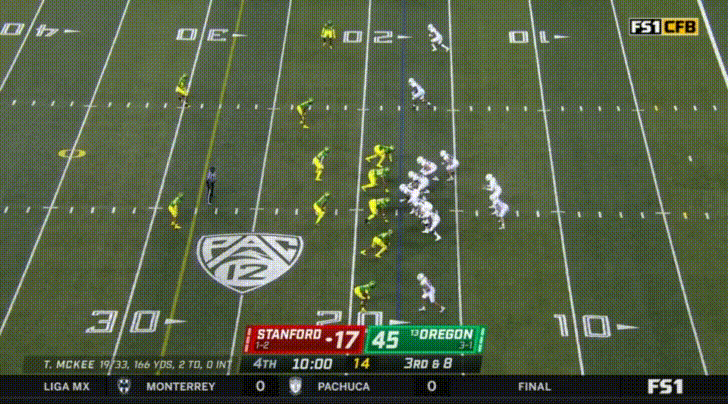






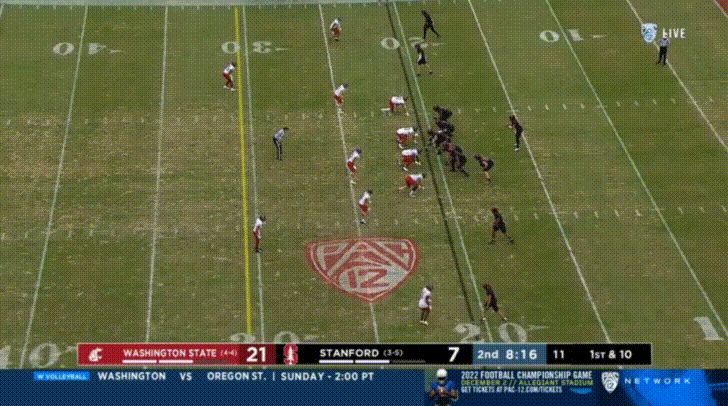





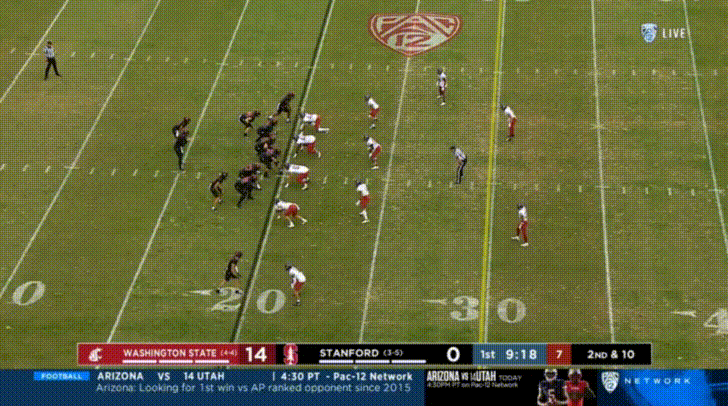




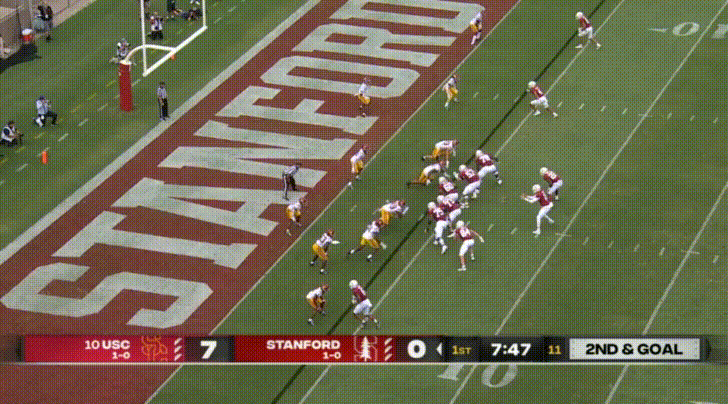

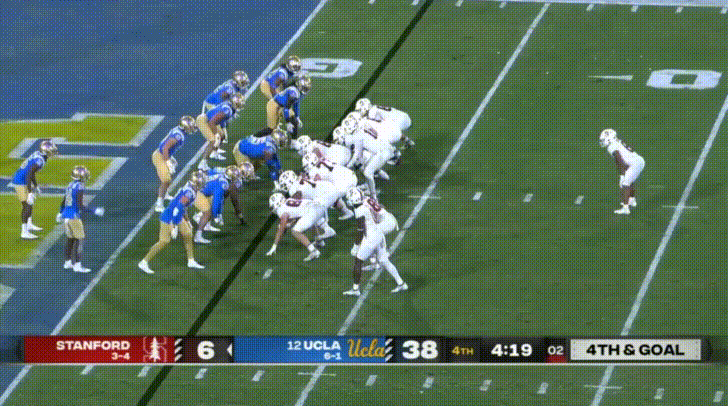

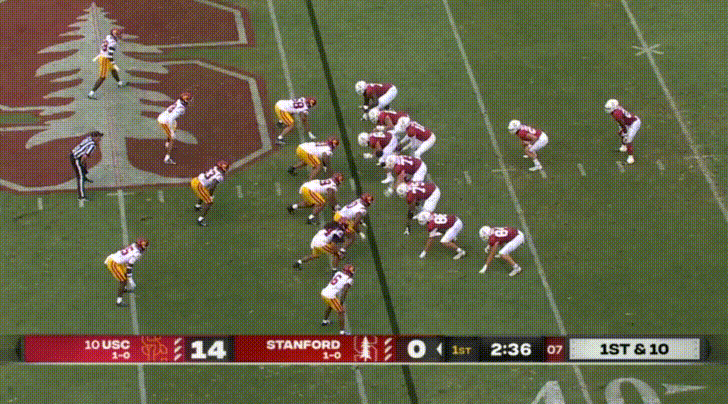


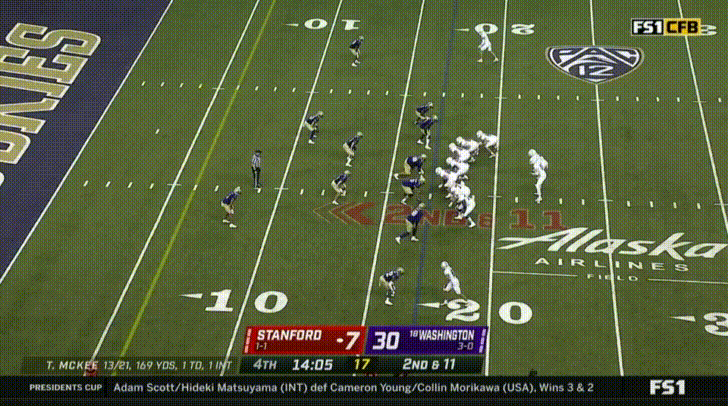





Thanks. Let's keep the axe.
CH for OC! As always, and especially given the trajectory of this season, I am most grateful for the time and effort the WFC staff puts into these articles.